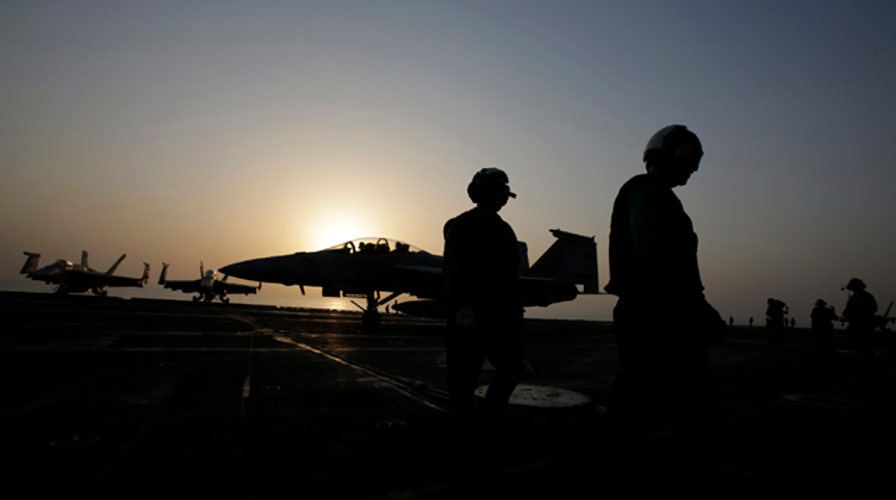The dangers pilots face in Iraq
What risks do US pilots face in air strikes and in the humanitarian mission in Iraq?
This is a rush transcript from "On the Record," August 13, 2014. This copy may not be in its final form and may be updated.
GRETA VAN SUSTEREN, FOX NEWS HOST: Take a look at this video. The Navy just recently released it. The pilots in the cockpits doing air strikes and air drops over Iraq. This what the pilots see. The pilots are in the air but still at risk. How much risk?
Joining us is retired Air Force Colonel Martha McSally. She was the first female pilot and is now running for an Arizona congressional seat.
Good evening.
COL. MARTHA MCSALLY, RETIRED AIR FORCE PILOT/CONGRESSIONAL CANDIDATE: Hi, Greta.
VAN SUSTEREN: You flew the A-10 Warthog, which I have learned is guardian in the sky to protect troops on the ground. Dangerous business doing this stuff. Tell me, how much are our pilots at risk who are doing air drops and also taking out certain ISIS members and their tanks?
MCSALLY: Well, every time we fly into enemy territory as a pilot, you know, we are at risk. You are at risk of potential small-arms fire or rocket-propelled grenades, RGPs or other missiles. We could have some sort of emergency where you have to eject. Every time we launch for one of these missions, you know, we are ready to go and survive on the ground, evade. We have got the training to be able to deal with that. You are always at risk every time you go on a mission like this.
Actually, the A-10 would be well-suited for this situation because we do fly low and very survival with longer times and hit targets and not hurt any friendly forces or civilians that are in close proximity.
VAN SUSTEREN: Could you neutralize ISIS from the air only or do you need ground troops?
MCSALLY: Well, if you have clear military targets, which you have had, and they're in isolated areas, you can go in with what we call JTACs, Joint Terminal Attack Controllers, and give the pilots the opportunity to find and identify those targets, hit them after they identify them.
It appears ISIS is changing tactics from less conventional and sort of blending in more with the population. It is much more difficult to do than without JTACs. You need to find and fix and finish those targets. And so doing that just from the air without the guy on the ground, saying that's the target, de-conflicted friendly forces, making sure there is no civilian casualties, that is very challenging to do just from the air, especially when they start blending more into the population.
VAN SUSTEREN: All right. Best case scenario, assuming we weren't all war-weary and concerned about some things, how do you take out ISIS?
MCSALLY: Well, you know, first of all, we should have seen this coming. The Obama administration has failed and just watched this threat as a cancer and metastasizing a cancer. It's been growing in its capability. It's been bank-rolling itself, you know. So we have seen this threat coming. And now we are already in a crisis because we have watched it happen and done nothing about it.
But it is a threat not just for the humanitarian situation. We cannot have a failed state in Iraq and Syria that is a safe haven for jihadists to be trained. They want to come out and obviously hurt us as well. So, this is an international crisis at this point that the Obama administration should have seen coming.
But he needs to start leading the international community in order to address this threat because it is a very serious threat. They are very capable, I would say, more capable than al Qaeda on 9/11. And it needs to be addressed seriously.
Right now, military solution is not the only answer, though. But we have got to take away those military capabilities and then address it politically as well.
VAN SUSTEREN: Colonel, thank you very much for joining us.
MCSALLY: Surely. Thanks for having me on, Greta.

